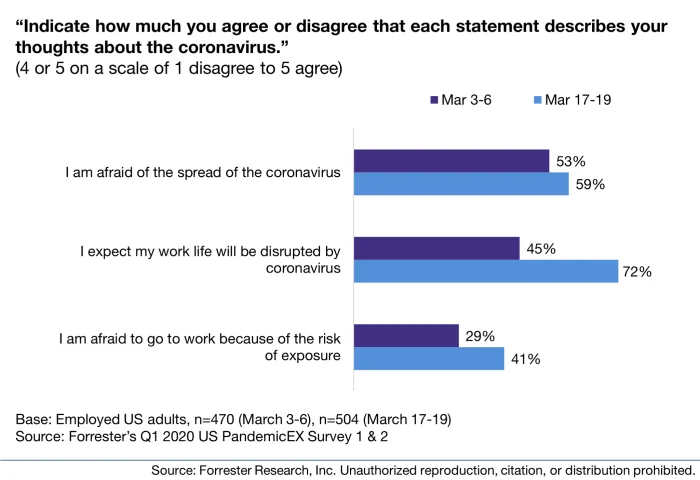Is it time for your company to create a ‘Head of Hybrid’ position?
According to Microsoft, 66% of leaders are considering redesigning their workplaces to support hybrid work. But, hybrid work is about more than your blueprint — it’s about how your people use these spaces. How can you create the best hybrid environment for your people to thrive? Most of us don’t know the answer yet — which is why 2022 may become the year of the Head of Hybrid.
While roles like GitLab’s Head of Remote, Darren Murph, and Facebook’s Director of Remote Work, Annie Dean, strive to help streamline the remote work experience, remote and hybrid are not the same. Designing a formal role focused on your hybrid work ensures you have a leader who can synthesize input from across the organization as different departments think through policies offering flexibility, digital investments, and other implications of this massive shift in how, where, and when we work.
Forging a united hybrid team
The pandemic caught everyone off guard, forcing a seismic shift in how we define work and revealing just how unprepared we are for change in this regard.
Now that the dust has settled, companies have the time and context to create new strategies for the hybrid era.
There is a need for leaders in the workplace that will drive those hybrid-work strategies. These individuals need to be capable of balancing the company’s needs with varying degrees of employee engagement and desire to return to the office.
Hybrid wasn’t really a challenge when the pandemic first hit. Nearly everyone outside of essential workers was forced to work from home. But now, the workforce dynamic is changing. Some employees work from home. Some work — or plan to work — in the office. Many fall somewhere in between.
The strategies employed months ago, when your entire workforce was remote, may not be effective any longer. In fact, they may become a cultural detriment that can easily lead to an ‘us vs. them’ mentality, pitting office workers against remote workers and leaving hybrid workers somewhere in between. “Managers of hybrid teams often need to make a concerted effort to ensure they do not associate with certain members of their team more closely merely due to location,” says Nick Deligiannis, Managing Director at Hays.
This ‘us vs. them’ divide is understandable when you have individuals who predominantly work in the office and those who work predominantly (or exclusively) remotely. Negative and unhelpful attitudes can creep in, like the notion that remote workers do less or have it ‘easy’.
It’s easy for team managers and others higher up in the organizational hierarchy to see people in the office as one team and those working remotely as an offshoot.
Current leadership roles will only highlight this divide. Appointing someone new to manage remote workers only emphasizes the belief that these individuals are ‘other’. A genuinely hybrid team — split between remote and office workers, with the locations of individuals changing day-to-day demands a new breed of leadership.
This person is someone who can bridge that divide and forge a united hybrid team.
“The worldwide shift to hybrid working models happening now is something most organizations have never had to deal with before,” says Ben Reuveni, CEO and co-founder of Gloat. “We’re seeing a number of new roles emerge within our talent marketplace that are designed to address this, with titles like Head of Hybrid Work, Head of Dynamic Work, and Workplace Environment Architect.”
Elsewhere we’re seeing companies like Unilever create entirely new roles, like the VP of Future of Work, developed to oversee their evolving model for hybrid work. New roles of this nature seem to be focused on ensuring a technologically connected team while navigating the complexities of HR, cultural, and leadership needs in a hybrid world.
What would be required of a Head of Hybrid?
This responsibility has naturally fallen on HR departments as a stopgap in the past. But with hybrid-specific needs, like maintaining employee affinity growing increasingly vital, it’s only natural that companies are beginning to evolve new roles to strategically manage their teams.
So what exactly would be required of a ‘Head of Hybrid’? Speaking of the possibility of a ‘Chief Hybrid Work Officer’ Gartner’s research director, Alexia Cambon argued, “Anyone in that role is essentially asked to shed the assumptions of the past and rethink work altogether. Hybrid work is going to involve a lot of experimentation…it makes sense to have a dedicated source.”
This thought helps form the outline of the skills required for this role — revolving key areas like emphasizing the ability to adapt, evolve, and grow with the emerging needs of the role.
Open communication
With the need to bridge the gap of managing team members in-person and remotely, communication skills will be vital. A flare for both synchronous and asynchronous communication is necessary to accommodate multiple locations, varying working hours, and different time zones. Seminal to this role would be the ability to ensure every employee enjoys equal voice, agency, and recognition — regardless of whether they’re communicating with the team in real-time or not, whether they’re physically present or not.
Tech-savvy
With so many solution-based tech offerings being developed for hybrid work, anyone in a Head of Hybrid role will need to be technologically savvy. It’s important for them to welcome and streamline the tech systems used by their teams, with the latest innovations, for the most efficient workflow.
They will also need the practical administrative chops to ensure all employees can easily access the required amenities. For example, a fast, quality internet connection and good bandwidth while working remotely are essential. Realizing this and ensuring the installation or payment of quality service for everyone in the most cost-effective way for the company is an essential base skill for such a role.
Confidence to be open-minded
Anyone stepping into a role of this nature needs to be inherently open to its newness. The need for a Head of Hybrid is emerging and will continue to evolve alongside hybrid working environments.
A fixed mindset of how things need to ‘get done’ will no longer be an advantage. Rather, a person comfortable and confident in both embracing and shaping new paradigms is in order. Someone capable of juggling the practical need to meet business objectives with the abstract nature of an evolving hybrid team, all while holding a role that is still being carved out.
Those currently occupying roles such as Head of Creativity or Innovation Manager have faced similar challenges. Yet they have forged and solidified these roles as vital elements of modern business development.
We no longer challenge prioritizing creative thought and innovative exploration over fixed practices and efficiency. Business evolution has always required us to periodically break the currently accepted status quo to discover a superior way of working.
Change is uncomfortable, yet evolution is necessary and would likely be a constant driving force behind any Head of Hybrid.
What would a Head of Hybrid role look like?
In a practical sense, it seems likely a Head of Hybrid role for most companies would be an evolution of existing management merged with the new roles – such as Head of Remote – that emerged during the pandemic.
For example, when Facebook was hiring a Director of Remote Work, they specifically sought ‘a strategic thinker who understands distributed and virtual teams, an outstanding relationship builder, and a change agent.’ This speaks to a company looking to the future and anticipating further evolution and change in the way we work and the manner in which teams interact.
Zapier, on the other hand, recently sought a Remote Communications Manager who could ‘design and maintain company-wide norms for our internal communication and collaboration strategy, tools, and processes.’ A natural evolution of such a role would be a Hybrid Communications Manager, who considers communication as a whole, rather than viewing remote as a separate entity to manage.
Such a role would require a person with a reasonable level of autonomy who is comfortable reporting to leadership and higher levels of management while maintaining enough altitude to view the company as a whole. Collaboration with HR and technical departments would undoubtedly be a necessity in order to ensure new policies were adapted and new technologies integrated to support the hybrid working model.
This would also extend to collaboration with workplace teams to ensure the best possible use of space within the physical office. Discussions across the board can help gain insight into what is and isn’t working in the office. Incorporating smart tech stacks into the workplace can be used to analyze and optimize these spaces, showing how our spaces are actually being used.
This would seem to be supported by existing requirements of companies hiring for similar roles. Cloudflare, for example, specified in their job description while seeking a Head of Distributed Work their need for someone capable of ‘working with our leaders and managers in creating a work environment where people can do their best work and teams can thrive, regardless of their work location or work mode’.
Does your company need a Head of Hybrid?
While some companies are opening themselves up to the need for new roles that effectively manage the practical needs of a hybrid team, it doesn’t automatically mean that every business will need to appoint someone to such a role.
On a basic level, however, with big names like Facebook and GitLab already having individuals in place to head up their remote efforts, with others like Gloat, Unilever, and Gartner, investigating the potential for a Head of Hybrid role, it seems likely this is another inevitable shift in the wake of the pandemic.
Like the need to work remotely, followed by employee reluctance to return to the office full-time, the integration of such a role into your business may simply be the next unavoidable opportunity of the pandemic.



